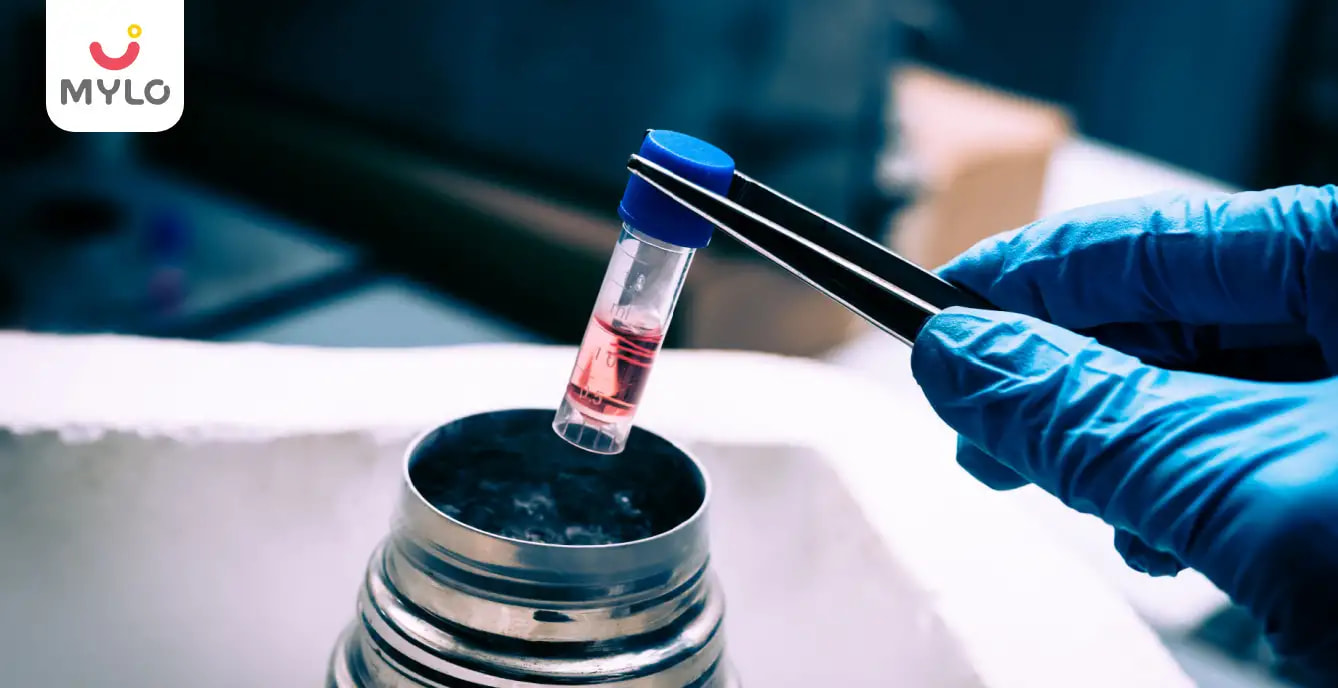Home

Stem Cell Banking

Stem Cell Banking: Meaning, Purpose & Benefits
In this Article

Stem Cell Banking
Stem Cell Banking: Meaning, Purpose & Benefits
Updated on 3 November 2023
Stem cell banking is the process of collecting, preserving, and storing stem cells for future use. For the first time in 2014, the Sanford Stem Cell Clinical Center at UCSD Health System announced a clinical trial to evaluate the safety of using neural stem cells for treating patients with spinal cord injuries.
Later, the same successful trial showcased the impressive life-saving capabilities of stem cells and promoted their usage for treating blood-related disorders and cancers.
Currently, stem cells can help treat over 80 blood-related diseases, with already 50,000+ transplants happening every year. Let us look at more details about this major breakthrough in medical science.
What Are Stem Cells?
Stem cells are special types of cells that can turn into many different types of cells in the body. They can make more of themselves through cell division and differentiate into specialised cells, such as blood cells, nerve cells, or muscle cells.
Multiple types of stem cells include:
-
Embryonic stem cells: Derived from embryos at a very early stage of development.
-
Adult stem cells: These are found in various body tissues, such as the bone marrow.
-
Induced pluripotent stem cells (iPSCs): These are artificially derived from adult cells by genetic reprogramming.
Stem cells can be used in regenerative medicine to replace cells that have been lost or damaged due to disease or injury.
How Do Stem Cells Work?
When stem cells are transplanted into the injury site, they help regenerate blood vessels and tissues that ultimately heal the wound.
For example - In the case of a patient with a spinal cord injury.
Stem cells could be collected from the patient's bone marrow or a donated source and then transplanted into the injury site. These cells then begin to divide and differentiate into the specific cell types needed to repair the damaged spinal cord. This could include cells that form new blood vessels, cells that produce the myelin sheath that surrounds nerve cells, and cells that form the supportive structure of the spinal cord.
As the stem cells differentiate, they begin to form new tissue. They also release growth factors and other molecules that help repair and regeneration. Over time, this process can lead to significant improvements in the patient's ability to move and feel, as well as improvements in their overall quality of life.
This is just one example. Stem cells are currently being researched for many diseases and injuries.
What Is Stem Cell Banking?
The process of stem cell collection at birth, preservation and storage for future use is called stem cell banking. The cells are typically collected from sources such as umbilical cord blood, bone marrow, or adipose tissue (body fat).
They are then cryopreserved at extremely low temperatures (-196°C). This allows the stem cells to be stored for long periods and retrieved whenever needed.
One can opt for private and public banking. Private banking means for personal use. Public banking is when stem cells are stored in a bank for use by anyone who needs them.
What Is The Purpose Of Stem Cell Banking?
The basic purpose of stem cell preservation is to preserve the cells for future use in case they are needed for medical treatment. The stored stem cells can be used to treat the person from whom they were originally collected. They can also be used to treat a family member who is a match.
The last updated report of the National Cord Blood Program in 2019 shows over 40,000 cord blood transplants worldwide, with an estimated 80-90% success rate. It’s surely working for most people and is a safe deposit for the future.
What Are The Benefits Of Stem Cell Banking?
The list of stem cell preservation benefits is huge. Some common advantages are worth noting.
-
Medical treatment: Stored stem cells can treat various medical conditions, such as cancer, genetic disorders, and immune system disorders.
-
Personalised medicine: These cells can help treat the person from whom they were originally collected or a family member who is a match. This allows for personalised medicine. Here, treatments are tailored to the individual's specific needs and genetic makeup.
-
Time-saving: If a person or family member needs a stem cell transplant, readily available preserved cells can save precious time that would otherwise be spent searching for a suitable donor.
-
Cost-effective: Stem cell banking can be cost-effective in the long run. It eliminates the need for repeated collection and storage.
-
Research: Stored stem cells can be used in medical research. They can help in improving treatments and finding cures for various medical conditions.
Although stem cells have many benefits, they are not without challenges. Always ensure to weigh the pros and cons before making a decision. It's always recommended to have a detailed consultation with a qualified healthcare professional to evaluate the suitability of stem cell banking for you or your family.



Written by
Parul Sachdeva
A globetrotter and a blogger by passion, Parul loves writing content. She has done M.Phil. in Journalism and Mass Communication and worked for more than 25 clients across Globe with a 100% job success rate. She has been associated with websites pertaining to parenting, travel, food, health & fitness and has also created SEO rich content for a variety of topics.
Read MoreGet baby's diet chart, and growth tips

Related Articles
Related Questions
Hello frnds..still no pain...doctor said head fix nhi hua hai..bt vagina me pain hai aur back pain bhi... anyone having same issues??

Kon kon c chije aisi hai jo pregnancy mei gas acidity jalan karti hain... Koi btayega plz bcz mujhe aksar khane ke baad hi samagh aata hai ki is chij se gas acidity jalan ho gyi hai. Please share your knowledge

I am 13 week pregnancy. Anyone having Storione-xt tablet. It better to have morning or night ???

Hlo to be moms....i hv a query...in my 9.5 wk i feel body joint pain like in ankle, knee, wrist, shoulder, toes....pain intensity is high...i cnt sleep....what should i do pls help....cn i cosult my doc.

Influenza and boostrix injection kisiko laga hai kya 8 month pregnancy me and q lagta hai ye plz reply me

Related Topics
RECENTLY PUBLISHED ARTICLES
our most recent articles

Diet & Nutrition
গর্ভাবস্থায় আলুবোখরা: উপকারিতা ও ঝুঁকি | Prunes During Pregnancy: Benefits & Risks in Bengali

Diet & Nutrition
গর্ভাবস্থায় হিং | ঝুঁকি, সুবিধা এবং অন্যান্য চিকিৎসা | Hing During Pregnancy | Risks, Benefits & Other Treatments in Bengali

Women Specific Issues
স্তনের উপর সাদা দাগ: লক্ষণ, কারণ এবং চিকিৎসা | White Spots on Nipple: Causes, Symptoms, and Treatments in Bengali

Diet & Nutrition
গর্ভাবস্থায় পোহা: উপকারিতা, ধরণ এবং রেসিপি | Poha During Pregnancy: Benefits, Types & Recipes in Bengali

Diet & Nutrition
গর্ভাবস্থায় মাছ: উপকারিতা এবং ঝুঁকি | Fish In Pregnancy: Benefits and Risks in Bengali

Diet & Nutrition
গর্ভাবস্থায় রেড ওয়াইন: পার্শ্ব প্রতিক্রিয়া এবং নির্দেশিকা | Red Wine During Pregnancy: Side Effects & Guidelines in Bengali
- ইনার থাই চ্যাফিং: কারণ, উপসর্গ এবং চিকিৎসা | Inner Thigh Chafing: Causes, Symptoms & Treatment in Bengali
- গর্ভাবস্থায় ব্রাউন রাইস: উপকারিতা ও সতর্কতা | Brown Rice During Pregnancy: Benefits & Precautions in Bengali
- Velamentous Cord Insertion - Precautions, Results & Safety
- Unlock the Secret to Flawless Skin: 7 Must-Have Qualities in a Face Serum
- Unlock the Secret to Radiant Skin: How Vitamin C Serum Can Transform Your Complexion
- Gender No Bar: 10 Reasons Why Everyone Needs a Body Lotion
- Unlock the Secret to Radiant Skin How to Choose the Perfect Body Lotion for Your Skin Type
- Top 10 Reasons to Apply a Body Lotion After Every Bath
- Communication in Toddlers: Milestones & Activities
- How to Improve Vocabulary for Toddlers?
- A Comprehensive Guide to Understanding Placenta Accreta
- Vulvovaginitis in Toddlers Causes, Symptoms and Treatment
- A Comprehensive Guide to Understanding Cerebral Palsy in Children
- Bitter Taste in Mouth During Pregnancy: Understanding the Causes and Remedies


AWARDS AND RECOGNITION

Mylo wins Forbes D2C Disruptor award

Mylo wins The Economic Times Promising Brands 2022
AS SEEN IN
















- Mylo Care: Effective and science-backed personal care and wellness solutions for a joyful you.
- Mylo Baby: Science-backed, gentle and effective personal care & hygiene range for your little one.
- Mylo Community: Trusted and empathetic community of 10mn+ parents and experts.
Product Categories
baby carrier | baby soap | baby wipes | stretch marks cream | baby cream | baby shampoo | baby massage oil | baby hair oil | stretch marks oil | baby body wash | baby powder | baby lotion | diaper rash cream | newborn diapers | teether | baby kajal | baby diapers | cloth diapers |








